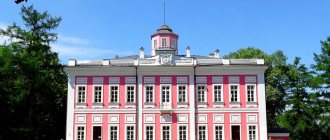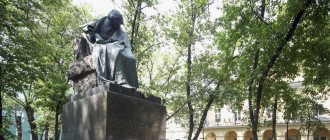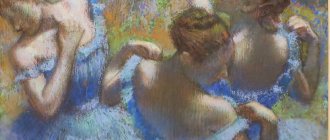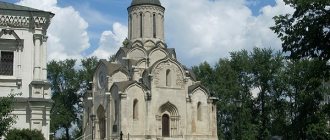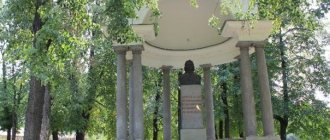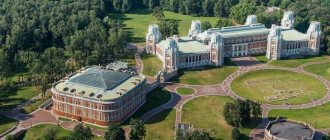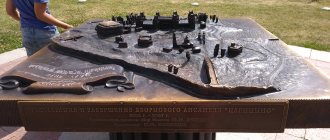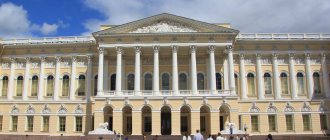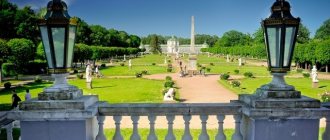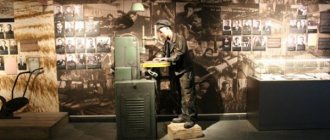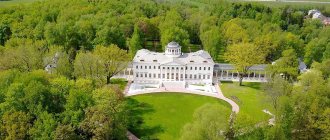History buff
John Doe.
Portrait of Nikolai Rumyantsev. 1st half XIX century A diplomat and politician, Count Rumyantsev was a passionate collector of antiquities. He was keenly interested in the history of Russia and collected books and manuscripts, letters on parchment and copies from chronicles. He did not forget about books either during his service in Europe or in his homeland - he bought valuable volumes and even entire printed collections. Rumyantsev also studied the traditions of the peoples inhabiting the Russian Empire. Over time, his library became one of the largest and most significant in Russia: it contained almost 30 thousand volumes, including valuable incunabula, early printed books, and geographical maps. Among them were the first editions of “The Lay of Igor’s Campaign” from 1800 and the extensive “Encyclopedia, or Explanatory Dictionary of Sciences, Arts and Crafts” by Denis Diderot and Jean Leron d'Alembert.
Being an enlightened man, Count Rumyantsev was a member of various societies, including the Imperial Russian Academy, the Arzamas literary circle, and the Society of Lovers of Russian History and Antiquities. And in addition, he organized his “Rumyantsev circle”, whose participants collected and studied materials related to the history of Russia.
In 1802, Nikolai Petrovich purchased a house on the English Embankment in St. Petersburg. His collection was also located here: in addition to a rich library, his collection included coins and medals, minerals and objects from archaeological expeditions, and ethnographic materials. The latter was facilitated by two important expeditions, which were organized with the financial support of Rumyantsev - the first Russian circumnavigation of Ivan Kruzenshtern and Yuri Lisyansky on the ships Nadezhda and Neva and the second circumnavigation of Otto Kotzebue on the brig Rurik. From both trips, researchers brought back important ethnographic monuments.
Rumyantsev Museum. Exhibit of the ethnographic department. Peasants of the Ryazan province. Photo: rmuseum.ru
Rumyantsev Museum. Ethnographic department. Photo by T. Mitreiter (circa 1880). Photo: rmuseum.ru
Rumyantsev Museum. Exhibit of the ethnographic department. Belarusian peasant women. Photo: rmuseum.ru
Rumyantsev's collection also included works of art. For example, a portrait of Nikolai Petrovich himself by George Dow, the artist who created the Military Gallery in the Winter Palace. And from his father, Count Pyotr Rumyantsev-Zadunaisky, the collector received the sculpture “Peace” by Antonio Canova.
In 1826, Count Rumyantsev died. He bequeathed a museum to be built in his house on the Promenade des Anglais. On March 22, 1828, Nicholas I signed a decree establishing the public institution “Rumyantsev Museum”. And three years later, on November 23, 1831, the doors of the museum opened to the public. Everyone, without exception, could visit the museum, and it was maintained by Nikolai Petrovich’s executor, his brother Sergei. For 30 years the museum was located in St. Petersburg, but over time its affairs went from bad to worse. In order not to lose the unique collection, it was decided to find a new home for it. It was found in the very center of Moscow.
LiveInternetLiveInternet
Quote from Maya_Peshkova's message
Read in full In your quotation book or community!
Palace of the Rumyantsev-Paskevichs in Gomel
The Palace of the Rumyantsevs and Paskevichs is an architectural monument of the 18th-19th centuries, the Palace on the canvas of M. Zalesky (19th century)
The palace and park ensemble in Gomel is a unique complex of monuments of nature, archaeology, history and architecture. Being the place of origin and development of the ancient city, it still remains the main link of its modern architectural image. Together with the historical part of Gomel, it is the only complete ensemble in Belarus and the most remarkable monument of the era of Russian classicism.
The compositional center of the palace and park complex, which was formed during the late 18th – 19th centuries, is the palace. It was founded on the site of the wooden castle of the last Gomel headman, Prince M. Czartoryski, by the outstanding commander of the Russian Empire, Field Marshal General Pyotr Aleksandrovich Rumyantsev-Zadunaisky, who received Gomel as a gift from Catherine II.
Ivan Starov, Yuri Felten
Work on the palace project began in 1777, construction began in 1785 and was completed in 1794. The author of the project was, perhaps, Ivan Starov, famous for the construction of the Tauride Palace and the Trinity Cathedral of the Alexander Nevsky Lavra. Among the authors of the project, the architect Yuri Felten, a student of Rastrelli, is also named. The construction process of the palace was directly led by the architect Ya. N. Alekseev, and Karl Blank advised him
Portrait of Field Marshal P. A. Rumyantsev-Zadunaisky
According to the existing legend, the outstanding commander Pyotr Aleksandrovich Rumyantsev was the illegitimate son of Peter the Great himself and the young Countess Maria Matveeva. The plausibility of this historical myth is supported by the attitude of Empress Catherine the Great towards Pyotr Rumyantsev. Every time she showed him royal honors and pampered him with expensive gifts. The old courtiers, who still remembered Maria Matveeva, also had no doubt that Pyotr Rumyantsev was really the son of the first Russian emperor. If we consider that all the Romanovs, including the descendants of Peter I, were subject to a deadly curse, it is not surprising that sooner or later it found its way to the Rumyantsev family. However, royal blood flowed in the Rumyantsevs’ veins one way or another. The Counts Matveevs were relatives of Peter I on the maternal side.
Nikolai Rumyantsev, the son of a field marshal, loved Gomel and did a lot for its development. The regrets of many contemporaries are associated with Nikolai Petrovich’s lack of heirs who would continue his father’s work. Nikolai Petrovich was educated at home and from the age of 9 was enrolled in military service. At the age of 19, he already became the chamber-page of Catherine II, and a year later, together with his brother Sergei, he went to study at Leiden University. Nikolai returned to Russia as a 25-year-old mature man, having visited Paris, Geneva, Berlin, Rome and Venice. At the age of 27, Nikolai Rumyantsev took up the post of minister plenipotentiary at the Diet of the Holy Roman Empire, becoming the representative of Russia in Europe.
According to the traditions of Russian aristocrats, marriage usually took place around the age of 40. And then one day, when Rumyantsev had already approached the groom’s age, Catherine II gave him a delicate assignment. Her 15-year-old grandson, the future Emperor Alexander I, needed to find a suitable bride. Catherine drew Rumyantsev’s attention to the granddaughters of the Margrave of Baden Karl-Friedrich - the four daughters of the Crown Prince of Baden Karl-Ludwig and his highly moral and virtuous wife Amalia. The daughters were famous for their good upbringing, good disposition, beauty and health. The Empress advised to take a closer look at the two older princesses - 13-year-old Louise-Augusta and 9-year-old Friederike-Dorothea.
If, in Rumyantsev’s opinion, the girls turned out to be worthy of the Russian Imperial House, it was necessary, having collected all the necessary information, to obtain the consent of the parents for the sisters to travel to St. Petersburg. Rumyantsev took a closer look. And he was immediately fascinated by the eldest, Louise-Augusta. Count Evgraf Komarovsky, who accompanied him on a trip to Karlsruhe, wrote about her this way: “I have never seen anything more charming and airy than her waist, dexterity and pleasantness in handling.” Rumyantsev became friends with the future Empress Elizaveta Alekseevna, but the relationship between them remained platonic. Correspondence has been preserved confirming the moral purity of their relationship. Moreover. Only Nikolai was in love. The beautiful Elizabeth, unhappy in her marriage, gave reciprocal feelings to other courtiers. There are suggestions that it was this romantic story that became an obstacle to Rumyantsev’s family happiness with any other woman in his circle.
The palace was built on the site of a wooden castle, which was built by the last Gomel headman, Mikhail Frederick Czartoryski, from the Czartoryski family. On July 10, 1775, Catherine the Great granted the Gomel headman to Count Pyotr Aleksandrovich Rumyantsev and allocated money from the treasury for the construction of the count's palace in Gomel
One of the sources of inspiration for the architects was the Villa Rotonda of the famous Italian architect Andrea Palladio.
The completed palace became one of the early examples of Russian Palladianism. It was a compact two-story building on a high base, completed in the center with a cube-like belvedere. The compositional center of the palace was a square hall with a dome.
The external decor of the palace was entirely made in the style of early classicism. The main decoration of the facades were porticoes of the Corinthian order - a four-column front porch and a six-column park one.
Along the entire perimeter of the building, rectangular window openings, placed in two rows, alternated with pilasters, which gave the palace a majestic monumentality.
On the high ground floor there were exclusively ceremonial premises, on the second there were living rooms, and the basement was used for household needs and accommodation of servants.
After Rumyantsev’s death, the palace was inherited by his son, the famous diplomat, statesman and philanthropist Nikolai Rumyantsev.
Nikolai Petrovich Rumyantsev invited architect John Clarke from England, who lived and worked in Gomel from 1800 to 1826. Clark not only rebuilt the Rumyantsev Palace, but also implemented the project of the Peter and Paul Cathedral, St. Nicholas Church in Volotov and the first Lancastrian school in Russia.
During the redevelopment and reconstruction of the palace, which took place from 1800 to 1805, Clark connected the service wings with the main building with galleries decorated with Ionic porticoes
Nikolai Rumyantsev kept a rich collection of books in the palace, which after his death became the basis for the creation of the Russian State Library in Moscow.
In 1826, Nikolai Rumyantsev died, and the palace passed to his second son P.A. Rumyantsev - Sergei Petrovich Rumyantsev, who in 1828 pledged the castle, and in 1834 sold it to the treasury.
Tower of the Rumyantsev-Paskevich Palace, view from the Sozh River
In 1834, the palace was bought by the famous Russian commander I.F. for 800 thousand rubles. Paskevich. Under him, in 1837-1851, under the leadership of the Polish architect Adam Idzkowski, the palace was reconstructed and a magnificent park was laid out
Ivan Fedorovich Paskevich
Idzkowski began the reconstruction of the palace with the wings. A third floor was added to the northern wing, the internal layout was changed, and the Ionic porticoes were removed from the façade. The southern wing of the palace was dismantled to the ground - in its place Idzkowski erected a four-story tower (from 1850 to 1851).
The 32-meter-high tower had a clock mechanism on the top floor, as well as a veranda with a balcony. This building, which somewhat stands out from the general architecture of the building, was created as Paskevich’s personal residence. The owner of the house had a library here and a rich collection of works of art was kept.
Idzkovsky also made changes to the architecture of the main building: the semicircular windows of the belvedere were redone, and the pediment of the seven-column portico facing the Sozh River was changed. In addition, he added a veranda to this facade of the building. During the reconstruction, statues were installed on the cornices of the main building of the palace and galleries
The interior design work of the palace was supervised by the Italian architect Vincento Vincenti.
The monument to Prince Józef Poniatowski in Warsaw is the work of the Danish sculptor Bertel Thorvaldsen. The monument was commissioned in 1817. In 1829, a model of the monument was made in Warsaw. The sculpture was cast in bronze in 1832, but due to repressions after the November Uprising it could not be installed according to previous plans in front of the Governor's Palace.
The monument was confiscated and, disassembled, transported to the Novogeorgievsk Fortress (Modlin). In the 1840s, the monument was presented by Nicholas I to Ivan Fedorovich Paskevich, taken to Demblin (Ivangorod) and, finally, to Gomel, where it was installed near the Paskevich palace.
In 1842-1922, on the terrace of the palace park there was a monument to Prince Józef Poniatowski by Bertil Thorvaldsen, intended for Warsaw and taken by Paskevich from the Modlin fortress. In 1921, after the Treaty of Riga, which provided for the return to Poland of cultural property taken from it after 1772, the monument was returned to Warsaw.
Fyodor Ivanovich Paskevich and a portrait of Princess Irina Ivanovna Paskevich (née Vorontsova-Dashkova)
The last owners of the estate are the son of Field Marshal Fyodor Paskevich and his wife Irina. After refusing the offer of the son of a relative of the Rumyantsevs, Count Andrei Vasilyevich Ruban, to purchase the palace for 1,500,000 ml. rubles, the palace was confiscated by the revolution and its collections became the basis of the Gomel Regional Museum of Local Lore created in 1919, and Irina Paskevich was moved to a small apartment.
The palace, which was damaged during the Great Patriotic War, was restored after the victory and housed a museum and the Palace of Pioneers. In the second half of the 1990s, it was completely transferred to the museum. In 1995, a decision was made to carry out restoration work, as a result of which the interiors of the rooms of the palace of the 18th-19th centuries were recreated.
Monument to N.P. Rumyantsev in front of the palace
In 1996, a monument to Nikolai Rumyantsev by sculptor N.A. Ryzhenkov was erected in the park opposite the palace [8]. On the monument, Rumyantsev is depicted with a plan for the reconstruction of the city, on which the future Peter and Paul Cathedral is marked with a cross. The monument is decorated with the coat of arms of the Rumyantsev family with the motto “Not only with weapons”
In January 2007, six antique sculptures were installed on the pediment of the palace, which appeared after the reconstruction of the palace under Ivan Paskevich, carried out by Adam Idzkovsky, were removed in January 1856 by order of Fyodor Paskevich, and then disappeared during the wars. The sculptures of Euripides, Aphrodite, Athena, Ares, Nymph and Bacchus are made of marble chips, white cement and quartz sand, weighing 1000-1300 kilograms. The author of the statues is Belarusian sculptor Viktor Smolyar
The museum's collection is constantly updated. In particular, in 2009, the museum collection was replenished with about 2,000 items
In 2010, restoration workshops opened in the palace
Modern interior
Currently, the exhibitions on the 1st floor of the central part of the palace represent a historical reconstruction of the premises. Along with exhibition halls, some halls perform representative functions. Interiors were created that corresponded to their purpose: the Columned Hall, the “White Living Room”, the “Red Living Room”, the reception hall (the former “golden” dining room).
The compositional center of the palace is the columned hall. This is the largest room in the central part of the palace. The majestic vista into the Hall of Columns was formerly opened through three large doorways. The room is a two-story hall, which during the lifetime of the owners of the estate, the Rumyantsevs and Paskevichs, was assigned the role of the main stage in the theater of ceremonial life. It stands out both in size and scale. Its beauty is the architectural expressiveness of the space itself, which is covered by the dome.
Sixteen snow-white Corinthian columns surround the hall on the first floor. The central space contrasts with the darkened rooms surrounded on four sides and separated by colonnades and topped with arches, which today are decorated with female sculptures representing an allegory of the four seasons - “winter”, “spring”, “summer” and “autumn” - the work of the sculptor Slobodchikov IN AND. (completed in 2004).
In the hall there are busts of field marshals P.A. Rumyantsev-Zadunaisky and I.F. Paskevich. The second floor of the columned hall is surrounded by balconies and marble balustrades. The alternation of light and shadow, magnificent perspectives that revealed enfilades of ceremonial rooms - all this creates a feeling of spaciousness and solemnity.
In the summer, the doors of the columned hall on the side opposite from the main entrance swing open, and the public finds themselves on a vast semicircular veranda. From here you can see the water meadows beyond the Sozh River. And nearby on the lawn, in the shade of the foliage, hide unique vases (1840s), preserved to this day.
In the Gomel Palace of the Paskevich Princes, along with works of painting and decorative and applied art of a secular nature, there was a large collection of religious objects. Most of them were concentrated in the premises of the house church, built in 1857-58. in the northern risalit of the palace in honor of the arrival of Emperor Alexander II in Gomel.
Today this small chamber room is the exhibition “Cult Objects from the Museum Funds” of the Gomel Palace and Park Ensemble. The basis of this exhibition are objects that were located in the house church and chapel with the tomb of the princely Paskevich family of the late 19th - early 19th century. XX century and religious objects (icons, books, church utensils, priestly vestments) from the collection formed by the museum staff in the post-war period.
The White Living Room is the third largest room in the main building of the palace with an area of about 120 meters. Guests and residents of the palace gathered here during ceremonial meetings and receptions. In the middle of the living room, on a pedestal, there was a large ceramic vase, a product of the Imperial Porcelain Factory, presented by Emperor Nicholas I in 1841 to Prince I.F. Paskevich in memory of his visit to the Gomel Palace.
In the corners of the living room were placed gigantic colored glass candelabra, also gifts from the Russian Emperor. Unfortunately, the interior decoration items were not preserved, so it was decided to build a chamber hall here. Today, the White Living Room of the palace hosts various events, concerts of organ and piano music. On the stage of the White Living Room of the palace, concerts of the best vocalists, folk and honored artists of Belarus, Russia, France, Holland, etc. are held with great success.
The red living room under the estate owners was less formal. According to the architect's plan, it formed an important link in the front enfilade of the palace. Its size, and most importantly, its place in the suite next to the hall and dining room, determined its purpose over time. In the middle of the 19th century it was a portrait.
The need to create a kind of music salon led to the fact that in the 1870s, along with twenty portraits “painted in oil paint,” there was an organ (with three cabinets and 24 shafts) and a piano. Then the Red Living Room became one of Princess I.I.’s favorite rooms. Paskevich, the last mistress of the Gomel palace.
Nowadays, the Red Living Room is one of the most beautiful halls of the palace, the interior of which is filled with both genuine objects of that time from the museum’s funds and copies of portraits of royal persons made by Gomel artists.
During the time of the Paskevichs, the palace was not only a magnificent architectural structure, but also a unique repository of the richest collections of antiquities and works of art. Its interiors were decorated with paintings and sculptures by famous Russian and foreign masters, collections of art glass from England and Bohemia, porcelain from Germany, England, Russia and China, bronze watches and candelabra from France, carpets and tapestries from Iran, Turkey, Bukhara and Germany , furniture by Italian, French, German and Oriental masters.
The famous Russian art critic Georgy Lukomsky, who visited the Paskevich estate in 1913, wrote that it had no equal not only in Belarus, but throughout Russia. Representatives of the royal family visited the Gomel Palace, including Emperors Alexander II and his wife and Nicholas II.
The second largest room in the main building of the palace is the former “golden” dining room of the Paskevich princes. It is located to the left of the columned hall, away from the main transverse enfilade. It was nicknamed “golden,” probably because of the gold and silver dishes placed on the walls, as well as Saxon porcelain. The middle wall was occupied by two ceremonial portraits of Field Marshal I.F. Paskevich and his wife Elizaveta Alekseevna, works by the artist N.G. Schilder (now the portraits are on display in the palace tower). The hall displays the “Portrait Gallery of Famous People of the Gomel Region” - ceremonial portraits of people who glorified the Gomel region far beyond its borders.
Irina Ivanovna Paskevich
She was the daughter of the chief master of ceremonies, actual secret adviser to Count Ivan Illarionovich Vorontsov-Dashkov and his wife Alexandra Kirillovna, the most influential lady in St. Petersburg, the mistress of a fashionable aristocratic salon. Irina inherited from her parents a charming appearance, a sharp mind, prudence, and it was not without reason that she was the subject of universal adoration.
One day she met Fyodor Ivanovich Paskevich, the son of a famous commander. In 1853, the young people had a noble wedding and settled in the Paskevich house on the English Embankment in St. Petersburg. The young people lived very secluded lives, as the English envoy Horace Rumbold wrote about in his memoirs, although the house, overflowing with collections of weapons and art objects, was loved by the capital's sybarites.
After his father's death in 1856, Prince Fyodor Ivanovich, who took over the titles, took over his father's inheritance, including Gomel. The prince and princess often traveled, and the townspeople learned about their presence in Gomel by the flag hung on the palace tower.
The commander's son did not achieve as much success as his father, although he did a lot during the period of the military reform that began. But Princess Irina Ivanovna became the real pride of Gomel (as well as the entire empire). She took up literature and became the first to translate Leo Tolstoy's novel War and Peace into French. It was her translation that blew up reading France. And then she translated the novel into English, Hungarian, Dutch, Polish and Turkish.
Monument to Irina Paskevich
And ordinary townspeople were amazed by the charitable activities of Princess Irina Paskevich, unprecedented for that time. On her initiative and with family funds, a free girls' school on the outskirts of the city, a shelter for orphan girls, a children's shelter for the city's care of the poor, and an almshouse for elderly women were maintained. In orphanages, Irina Paskevich personally selected the most capable children and provided them with education, trained specialists, and paid scholarships. With the money of the Paskevichs, the Gomel men's classical gymnasium was built in 1898 (now one of the buildings of the Belarusian State University of Transport). It should be noted that the Paskevich couple was honored at court and in 1857 Emperor Alexander II came to visit them in Gomel, who was struck by the splendor of the palace .
She seemed to live with human problems. Through her efforts, at the Dobrush stationery factory, owned by the Paskevichs, an eight-hour working day was introduced for the first time in Russia. In addition, at this time, Irina Ivanovna donated more than 250 thousand rubles for the construction of a neurosurgical clinic in St. Petersburg. When the First World War began, Irina Paskevich organized infirmaries in the city , helps with them herself. Emperor Nicholas II visited her hospital with gratitude.
Tomb of the Paskevich family.
The construction of the family crypt began in 1865 with a long process to resolve the issues of “permission to build a family chapel on city land” and permission to exhume and transport to Gomel the remains of his parents from the Polish estate in the village of Ivanovsky, Lublin Voivodeship, as well as his grandparents from the Shcheglitsy estate in the Mogilev region. Construction began in 1870 and lasted 19 years.
Since 1995, repair and restoration work has been carried out in the central and left wings. The restoration of the palace tower was completed, and on July 3, 2003, a new museum exhibition was opened. Its visitors can not only view the rich interiors, but also learn about the former owners of the Gomel estate and see original works of art that were once housed in the palace.
On both sides of the main hall of the palace - the columned one - there are perspectives of the light-filled columned galleries of the palace. Large rooms lead to them, called living rooms - rooms for receiving guests. These rooms did not have any special purpose, and in conversation among themselves the owners of the palace, the Paskevichs, distinguished them by color - “red” and “white”. The white living room opened the way to the possessions of Prince Paskevich - a pavilion and a tower, where everything was permeated with memories of military exploits. The red living room led to the house church.
Table with the image of the French king Louis XVI and the ladies of the court. Second half of the 18th century France
This sad man with a hole instead of an organism is Francisco de Miranda (1759-1816). The first Latin American to visit Russia, where he went in the 18th century, seeking assistance in the implementation of plans for the liberation of South America - a dream that was supported by Field Marshal P.A. Rumyantsev-Zadunaisky.
In 1814, by order of Nikolai Petrovich, the famous Italian sculptor Antonio Canova carved a statue of Peace from marble with a Maslenitsa branch and a staff in his hands, trampling evil with his feet, in the form of a snake. She became the personification of the peaceful deeds of the three Rumyantsevs, who concluded peace treaties - Abosky, Kyuchuk-Kainardzhiysky and Friedrichsgamsky. A student of Antonio Canova, sculptor V.I. Demut-Malinovsky made a bronze copy, which was installed on the grave of Nikolai Petrovich Rumyantsev in the Peter and Paul Cathedral. On the monument in gold letters was inscribed: “He gave back to the Gods, Caesar to Caesar, to the Fatherland with love and sacrifice.” The statue lost its arm during the last war.
Chess table
https://fotogorodov.ucoz.ru/blog/gomel/2014-07-17-223
https://www.palacegomel.by/
https://www.palacegomel.by/index.php?do=static&page=photo
Andrey Samusik. Palace and park complex of the Rumyantsev-Paskevichs. "Recreation and Travel", No. 12, 2002
https://www.palacegomel.by/index.php?do=static&page=history
https://users.livejournal.com/-twin-/449980.html
https://poltava.to/news/9281/
https://www.sb.by/life/article/proklyatie-gomelskogo-dvortsa-sushchestvuet-li-ono-na-samom-dele.html
Series of messages “Palaces of the World”:
Part 1 - Ryumin Palace in Lausanne. Part 2 - Palace-Monastery da Mafra (Marfa, Portugal) ... Part 47 - Rundāle Palace. Part 2. Interiors Part 48 - Park and Kadriorg Palace. Part 49 - Rumyantsev-Paskevich Palace in Gomel
Series of messages “Castles of Belarus”:
Part 1 - Black Olshansky Castle. Belarus Part 2 - Ancient castles of Belarus. Part 1. ... Part 8 - Nesvizh... Belarus: around the city Part 9 - Secrets of the Radziwill Castle Part 10 - Rumyantsev-Paskevich Palace in Gomel
Admission is free on Sunday
On the basis of the museum, it was decided to create a public library, following the example of the St. Petersburg one. Trustee of the Moscow educational district Nikolai Isakov played an important role in this. He convinced the collection to be transferred from St. Petersburg to Moscow and found a building that could accommodate the Count's impressive collection. The choice fell on the house of a retired officer and businessman Pyotr Egorovich Pashkov, located opposite the Kremlin, in other words, the Pashkov House. While preparatory work was underway, an exhibition of gifts to the new museum was held in the halls on Mokhovaya: from the Academy of Arts - canvases by Dmitry Levitsky and Karl Bryullov, paintings from German painters Wilmeer and Mayer. And from the main patron of the museum - Emperor Alexander II - paintings from the Hermitage, engravings and works of Ural stone cutters.
Alexander Ivanov. The appearance of Christ to the people. 1837-1857. State Tretyakov Gallery
Dmitry Levitsky. Portrait of N.A. Sezomov. 1770. State Tretyakov Gallery
Ivan Aivazovsky. Marine view by moonlight. 1878. Astrakhan State Art Gallery named after P. M. Dogadin
The grand opening of the new Moscow museum took place in 1861. The public could visit it four days a week by paying 10 kopecks, and on Sunday the museum was open for free. In Moscow, he knew no shortage of gifts: the art collection was constantly replenished. The main donor was the emperor. Thanks to him, more than two hundred paintings from the Hermitage and the largest work by Alexander Ivanov, “The Appearance of Christ to the People,” which, together with sketches for the canvas, were purchased especially for the Rumyantsev Museum, appeared in the Pashkov House. The extensive collection of Fyodor Pryanishnikov also came here, which included paintings by outstanding Russian painters - Aivazovsky, Tropinin, Venetsianov and others. The museum also received financial support. For forty years, businessman Kozma Terentyevich Soldatenko donated a thousand rubles to him for the purchase of books, and then bequeathed his library (it numbered 8 thousand volumes) and a collection of Russian paintings.
A masterpiece for everyone
Karl Bryullov. Genseric's invasion of Rome. 1833-1835. State Tretyakov Gallery
Vladimir Borovikovsky. Virgin and Child. No later than 1825. State Tretyakov Gallery
Alexey Venetsianov. Communion to the dying. 1839. State Tretyakov Gallery
In 1924 the collection was divided. The collection of books became the basis of the Library. Lenin (now the Russian State Library), paintings and sculptures were distributed to museums. The movement of collections took place until the early 30s: the last painting to leave the art gallery was by Alexander Ivanov.
The richest ethnographic collection returned to the Northern capital - to the Russian Ethnographic Museum. The treasures of the antiquities department went to the funds of the Historical Museum, the jewelry - partly to Gokhran, and partly to the State Museum Fund. A significant part of the painting collection entered the Tretyakov Gallery: paintings by Karl Bryullov from the Soldatenkov collection - “Bathsheba” and “The Invasion of Genseric on Rome”, “The Virgin and Child” by Vasily Borovikovsky and “Communion of the Dying Woman” by Alexei Venetsianov from the Pryanishnikov collection. As on Mokhovaya, a separate hall was equipped for the painting “The Appearance of Christ to the People” in the Tretyakov Gallery.
Isaac Levitan. Birch Grove (Path). 1889. North Ossetian Republican Art Museum named after M.S. Tuganov
Valentin Serov. Portrait E.A. Balina. 1911. Nizhny Novgorod State Art Museum
Rembrandt. Artaxerxes, Haman and Esther. 1660. State Museum of Fine Arts named after A.S. Pushkin
Paintings by Pyotr Fedotov, Fyodor Matveev, Isaac Levitan, Henryk Semiradsky, Valentin Serov—their number is countless—went to republican museums. “Lucretia” by Lucas Cranach the Elder can now be seen in the collection of the Nizhny Novgorod Art Museum, the painting “Apostles Paul and Barnabas in Lystra” by Jacob Jordaens - in the Perm Art Gallery. At the Pushkin Museum named after. Pushkin has one of the paintings that Alexander II donated to the Rumyantsev Museum from the Hermitage - Rembrandt’s Artaxerxes, Haman and Esther. And canvases from Shchukin’s collection went to St. Petersburg.
Palace of the Rumyantsevs and Paskeviches today
Nowadays, the former residence of aristocrats in Gomel is one of the most interesting and most visited museums in Belarus , a major historical, cultural and educational center.
The first floor of the central part of the palace is a historical reconstruction of the premises of a noble estate. As in ancient times, the Hall of Columns, the White Living Room, the Red Living Room, and the reception hall (the former “golden dining room”) are located here.
Today these halls are not only part of the exposition, but also a venue for balls and concerts , meetings and negotiations with the participation of top officials of states. The Gomel Palace often hosts exhibitions (paintings and other art objects, photographs), and interesting educational projects.
the Gomel Palace and Park Ensemble Museum one of the richest in Belarus : archaeological, ethnographic, numismatic collections, collections of paintings, handwritten and early printed books, icons and religious objects, marine organisms, memorial complexes of prominent people (aircraft designer Pavel Sukhoi , Foreign Minister Andrei Gromyko )…
The tower, rebuilt according to the design of Ivan Fedorovich Paskevich, houses the exhibition “Owners of the Gomel Estate, the Rumyantsevs and Paskeviches . It presents authentic paintings, sculptures, weapons and personal belongings of the princes.
In 2012, the Gomel palace and park ensemble of the Rumyantsevs and Paskeviches received the Grand Prix of the competition “Museums of Belarus for the Third Millennium” .
Spinoza for Komsomol members
Alas, some works were unlucky: for example, only a small part of the furniture ended up in the museum collection. Someone else liked the chairs and tables. For example, Komsomol members from the Lenin Club, without waiting for the official commission to distribute the valuables, themselves took out a marble table, chairs, candelabra and even a bust of Spinoza. And they left an explanatory letter - they say they took it for the improvement of the club. And Rembrandt’s canvas “Christ with folded hands” from the collection of Counts Orlov-Davydov was stolen in 1927, barbarously cut out of the frame. Five years later, the painting (on the eve of the revolution it was valued at 200 thousand rubles) was found and, after restoration, sold abroad. Today it is in the Hyde Museum in Glens Falls, America.
